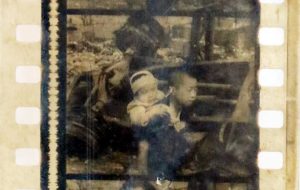Striving to fill voids in Hiroshima, evidence of victims remains—Hideo Takemoto, young boy in film and resident of Kure City, shares account of A-bomb experience for first time
Jul. 16, 2022
Now understands preciousness of his own life, saved by older brother
by Nene Takahashi, Staff Writer
In a film that captured scenes of Hiroshima shortly after the atomic bombing in 1945, a young boy is carried on the back of his older brother. The boy, wrapped from head to cheek in a bandage and staring intently into the camera, is Hideo Takemoto, 80, who now lives in the area of Kurahashi-cho in Kure City. This summer, 77 years after the atomic bombing, Mr. Takemoto shared his A-bombing experience, for the first time, at a gathering of children that took place in Higashihiroshima City, located to the east of Hiroshima.
Hideo, three years old at the time of the atomic bombing, experienced the bombing at his home in the area of Otemachi, located in Hiroshima’s Naka Ward, about one kilometer from the hypocenter. He became trapped under the collapsed house but was pulled out from underneath and thus rescued by his brother Sadao, who was 11 years old at the time. Hideo explained, “The house burned to the ground shortly thereafter. If my brother had not been there, I would not be here today.”
A wound on his left cheek was so deep that the bone was visible, and later the wound formed into a thick, raised keloid scar. Hideo underwent surgery to remove the keloid when he was 19. Recalling the surgery, he said he would never forget the sound of the keloid scar being shaved off.
Two months after the atomic bombing
The scene of the young boy is from a documentary created by staff of Nippon Eigasha (a film company that would later be dissolved). Hideo has in his possession part of the film segment in which he appears. When his brother-in-law was watching a documentary movie about the atomic bombing at a movie theater in Tokyo several decades ago, he realized that the Takemoto brothers were in the movie and asked the projectionist for the three shots of the scene that showed the two brothers. The scene is said to have been filmed about two months after the atomic bombing near the Hiroshima Red Cross Hospital (present-day Hiroshima Red Cross Hospital & Atomic-bomb Survivors Hospital, located in the city’s Naka Ward). Hideo speculates that he and his brother were on their way to the hospital to have his wound treated.
Sadao was killed in a traffic accident when he was 23. While alive, he apparently never spoke of the atomic bombing. Hideo said, “When I look back at it now, I have lots of things that I would like to have asked him. First of all, though, I’d like to thank him for saving me.” Hideo cherishes an enlarged photograph of his brother from the film scene displayed in the room in which the family Buddhist family altar is located.
Each year, with the approach of August 6, it is not unusual for the documentary with the scene of the brothers to be featured on television. Nevertheless, other than close acquaintances, he has never revealed to anyone the fact that he is the boy in the film. He would tell himself that there was not much to say and that he would just as soon maintain his privacy.
It was last year when he had a change of heart. Sumihiko Kitagawa, 76, a resident of the area of Kurose-cho in Higashihiroshima City who remains his closest friend over the last 50 years and is a member of Higashihiroshima Gensuikyo (Japan Council against Atomic and Hydrogen Bombs), asked Hideo for permission to display photos of the brothers at an A-bombing exhibit. Hideo says, “When I saw that other A-bomb survivors were sharing their experiences in the atomic bombing, I came to the conclusion that I should do the same.” After talking it over with his wife, he decided to share his A-bomb experience for the first time.
Thoughts expressed through tears
At a testimony event held in conjunction with the A-bombing exhibit at Higashihiroshima City’s Kurose Lifelong Learning Center on July 10 earlier this year, about 70 people gathered. With tears in his eyes, Hideo spoke of his feelings of gratitude to his brother and the tragedy and misery brought on by the war. To the children present at the event, he said, “I want you to be kind and not resort to bullying others. That will serve as a foundation for the elimination of war.”
After his testimony, Hideo smiled and said, “I feel relieved, as if a curse had been broken.” He then vowed, “I’ll continue to live my life without forgetting my sense of gratitude to my brother.”
(Originally published on July 16, 2022)









